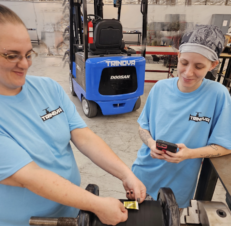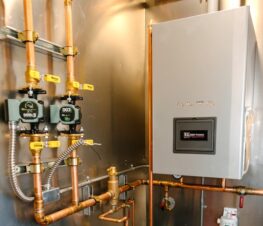By Carol Foster
Every jobsite offers unique challenges. When it comes to higher-end residential or commercial installations, there are typically few choices to make selecting the right solution for plumbing, process, wash-down or exterior surface drainage: ductile iron, PVC, copper and nickel bronze are the usual candidates. Now, forcing their way into the mix for designers, specifiers and installers today are new, über-versatile stainless steel and plastic technologies.
It only makes sense, as new products are rushing in to improve all facets of building performance – from hydronic efficiency to water use, re-use and backflow prevention – that drainage technologies advance as well. But given their behind-the-wall, under-the-floor, bad breath status, the often lowly, maligned drain is often last on the list for specifier consideration. A recent entry onto the drainage “stage” has been the introduction of stainless steel systems. A wide variety of extremely durable, aesthetically-pleasing drainage pipe, fittings and trim have entered the global market, many of which got their start in Europe.
For example, Blücher, a Watts Water Technologies company, is recognized as a leading global manufacturer of stainless steel drainage systems for applications ranging from residential bathrooms to large industrial facilities. Stainless steel ensures high quality and offers outstanding flow characteristics with minimal maintenance.
Commercial + industrial use
Hospitals, hotels, shopping malls, and airports all benefit daily from the performance of stainless steel drainage solutions. Properly treated, low-porosity stainless steel has a uniquely smooth surface that guarantees excellent hygiene and resistance to bacteria-laden biofilm.
Stainless steel is also a strong, durable, pressure-and chemical-resistant material. Due to excellent material properties, with stainless steel, the weight of a drainage system can be reduced by more than 75 percent compared to cast iron; this contributes to ease of installation. Stainless steel is also entirely recyclable and non-toxic, making it an environmentally friendly solution, also favored by the USGBC for LEED certification.
Stainless steel drainage systems are also ideally suited for use in the food and beverage industries as well as pharmaceutical and chemical plants. Stainless steel floor drains with gas-tight covers, flushing-rim drains, dual-contained drains, pipes and channels provide superior fluid drainage from production areas, labs and clean rooms.
Stainless steel: ideal for hi-temp plumbing
In an interesting application south of the border, a 164,000 s.f., three-story, $80 million prison kitchen/warehouse facility is now being built in New Orleans that will soon have the capacity to prepare 25,000 meals every 12-14 hours if needed. It can also preserve meals in its freezer for up to 45 days. One of the most unique facets of the new facility’s construction was the specification for 8,000 lineal feet of stainless steel drainage piping, chosen because of the resilience and thermal characteristics of the material.
“Stainless steel was the ideal material for the job,” explained Jamey Logrande, vice president and senior project manager with Metarie, LA-based design engineering firm Huseman & Associates. Experts there were responsible for design of the building’s electrical, mechanical, plumbing and fire protection systems. “With stainless steel, bacterial growth in the drainage system is greatly reduced,” added Logrande. “And, of course, the very nature of this building is to assure permanence and durability.”
The material chosen by the general contractor, New Orleans-based Woodward Design-Build, was stainless steel pipe supplied by Blücher.
“We needed a plumbing system that could routinely move liquids at temperatures of up to 250° to 260°F because of the multiple 300-gallon steam pressure cookers dumping into the waste system,” explained Logrande.
“Blücher has optional stainless steel gaskets that are rated for use at temperatures up to 390°F,” added Logrande. “And we needed to exceed the rated maximum temperatures for cast iron couplings and gaskets – just 210°F – so stainless became our choice for the best material for the job. ”The sometimes super-high temperature of heavy, semi-fluid, cooked goods was a key concern, but so was the weight and volume of the mass being drained in the large steel pipes used to transport soups and stews to packaging machines.
“We knew of the need for massive dumping of high-temp fluid on a regular basis and, with very expensive, very temperature-sensitive food storage spaces below the kitchen, we knew there’d be no room for error,” said Logrande. “We can’t afford a leak; the result would be catastrophic.”
Ships ahoy
Stainless steel sanitary discharge systems have also proven their reliability in more than 10 million lineal feet of piping aboard cruise ships, ferries, luxury yachts, naval vessels, cargo vessels and offshore platforms.
The marine industry relies on the performance of stainless steel drainage solutions at sea, where durability and light weight are essential. Clean and hygienic conditions in cabins, kitchens and sanitary facilities are important elements contributing to efficiency onboard.
Dead-on trench drains
Another example of commercial drainage innovations is new, lightweight, plastic trench drains. This technology such as the Watts’ DeadLevel™, are pre-sloped trench drain systems. Each drainage system comes complete from the manufacturer with channels assembled to frames, grates, lockdowns, frame connectors, end caps, construction covers that eliminate the unpleasant task of attempting to remove hardened concrete from the channel after the pour.
With a simple sketch, showing lengths, flow direction and outlets – professionals can prepare a package or a list of components to complete the required layout. Systems do not necessarily have to be sloped. In fact, neutral trench runs are frequently installed where the ground is already pitched, or where depth constraints restrict the use of deeper channel sections. A two-man crew with rebar driver and laser level can easily set a 100′ (30m) drain system in less than a day.
Author bio:
Carol Foster is the North American product manager for drains and BLÜCHER for North Andover, MA-based Watts Water Technologies. Carol, based in Ontario, Canada, is responsible for all commercial drainage business management.




Join the conversation: